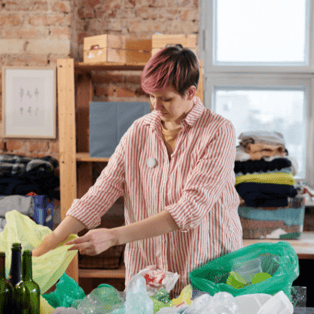Simplify Your Space, Save the Planet: Sustainable Decluttering
How to declutter responsibly by donating, upcycling, and repurposing items.
.png?width=941&height=390&name=reduce%2c%20reuse%2c%20recycle%20(2).png)
Decluttering your home can feel like a massive task, but what if it was more than just making space? What if every item you let go of had a second life—helping someone in need, reducing waste, or becoming something brand new?
At Queen of To Do, we know decluttering isn’t just about organizing—it’s about making mindful choices that support your home, your community, and the planet. Here’s how to declutter responsibly while keeping sustainability at the heart of the process.
1. Start With Purpose
Before you dive in, it’s important to pause and think about why you’re decluttering. Beyond just making space, what are your deeper goals? Maybe you want to simplify your life, reduce stress, or ensure your belongings are helping someone else instead of gathering dust.
Ask yourself:
- What’s worth keeping? It’s easy to fall into the trap of holding onto things “just in case.” Be honest about what adds value to your life versus what’s simply taking up space.
- Could someone else benefit from this? A well-placed donation can turn an unused item into a valuable resource for someone else.
- How can I minimize waste? Before discarding anything, consider if it can be donated, repurposed, or recycled to extend its usefulness.
Decluttering isn’t about perfection—it’s about making mindful choices. Every small step counts.
2. Donating: Where Your Things Can Shine Again
Donation is one of the most impactful ways to ensure your items are put to good use. But thoughtful donating is key to making sure your efforts truly help.
- Focus on quality: Think of the phrase “gently loved.” If you wouldn’t pass an item to a friend, it’s probably better suited for recycling or upcycling.
- Know where to give: Local organizations often have specific needs and can distribute your items where they’re most needed.
In Austin, Heartening does incredible work connecting donations to families and individuals who need them. Whether it’s clothing, furniture, or household goods, Heartening ensures that your contributions make a meaningful impact. It’s such a rewarding way to know your items are truly helping someone.
When donating, consider grouping items into categories like clothes, books, or kitchen supplies—it makes the process easier for both you and the organization!
3. Get Creative: Upcycling and Repurposing.png?width=359&height=359&name=reduce%2c%20reuse%2c%20recycle%20(3).png)
Not everything has to leave your home to find a new purpose. With a little creativity, you can turn “forgotten” items into something functional, beautiful, or both.
- Upcycle everyday items: Old jars can become storage for spices, office supplies, or even plant holders. An unused ladder can be a stylish blanket rack.
- Breathe new life into furniture: Sometimes, all it takes is a coat of paint or a little rearranging to transform a piece. An old coffee table can become a child’s play surface, or mismatched chairs can be unified with fresh upholstery.
- Engage your family: Upcycling can be a fun family activity. Kids love hands-on projects, and it’s a great way to teach them about sustainability while letting their creativity shine.
The beauty of upcycling is that it’s both practical and deeply personal. You’re not just saving money; you’re creating something uniquely yours.
4. Recycle the Right Way
For items that truly can’t be reused or repurposed, recycling is the next best step. But not all recycling is straightforward, and it’s worth taking the time to do it right.
- Research local options: Cities like Austin offer specialized recycling programs for electronics, textiles, and large items. A quick online search or call to your city’s waste management department can reveal surprising solutions.
- Break it down: Many items—like electronics or furniture—have recyclable components if you’re willing to disassemble them. This extra effort goes a long way in reducing landfill waste.
- Handle hazardous materials carefully: Items like batteries, paint, or old cleaning products often require special disposal. Be sure to check your local guidelines to avoid harm to the environment.
- For residents in Austin, the City of Austin's Recycle & Reuse Drop-off Center accepts a variety of household hazardous waste, including paints, cleaners, and automotive fluids. They provide safe disposal and even offer a ReUse Store where you can pick up free items that others have dropped off.
- In Dallas, the Dallas County Home Chemical Collection Center provides similar services, allowing residents to dispose of household chemicals responsibly. They accept items like paint, pesticides, pool chemicals, motor oil, and other automotive fluids.
It may feel like extra work, but recycling thoughtfully ensures your items are helping the planet instead of harming it.
5. Plan for a More Sustainable Home
Decluttering is a great start, but maintaining a sustainable, clutter-free space takes intention. By developing mindful habits, you can keep your home feeling fresh while reducing waste long-term.
- Buy less, choose better: When shopping, ask yourself if you truly need the item or if there’s a secondhand option available. Investing in quality pieces can prevent clutter and save money in the long run.
- Adopt a “one in, one out” rule: Whenever you bring something new into your home, let go of an old item. This keeps your space balanced and prevents unnecessary accumulation.
- Create systems that work for you: Simple organizational tools, like labeled bins or rotating seasonal items, can keep clutter from creeping back in.
Sustainability isn’t about being perfect—it’s about making small, consistent choices that align with your values.
6. Small Steps, Big Impact
Decluttering sustainably doesn’t mean you have to overhaul your entire home overnight. Start with one small project: maybe that drawer full of random cables, the corner of your closet that’s become a catch-all, or a few toys your kids have outgrown.
When you donate to organizations like Heartening, creatively repurpose old items, or recycle responsibly, you’re creating ripples of kindness and care. It’s not just about creating physical space—it’s about making room for joy, connection, and intention in your life.
Declutter With Heart
At its core, sustainable organization is about more than tidying up. It’s a chance to align your home with your values and make a difference in the world around you. By donating thoughtfully, upcycling creatively, and recycling with care, you’re turning decluttering into a meaningful act of kindness.
So, take a breath, start small, and remember: every step you take toward sustainability is a step toward a lighter, brighter, and more intentional home.
-1.png?width=600&height=200&name=Untitled%20design%20(28)-1.png)




